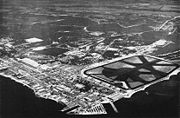
Chevalier Field
Encyclopedia

Naval Air Station Pensacola
Naval Air Station Pensacola or NAS Pensacola , "The Cradle of Naval Aviation", is a United States Navy base located next to Warrington, Florida, a community southwest of the Pensacola city limits...
, Florida. Established originally in 1922 as Station Field, it was located on the northeast side of the Navy base, on the western edge of Pensacola Bay
Pensacola Bay
Pensacola Bay is a bay located in the northwestern part of Florida, United States, known as the Florida Panhandle.The bay, an inlet of the Gulf of Mexico, is located in Escambia County and Santa Rosa County, adjacent to the city of Pensacola, Florida, and is about 13 miles long and 2.5 miles ...
and south of Bayou Grande. The small town of Woolsey, just north of the Navy Yard, was razed for the creation of the airdrome.
Expanded in 1935, it was renamed Chevalier Field on 30 December 1936 for Lt. Cdr. Godfrey DeCourcelles Chevalier
Godfrey Chevalier
Lt. Cdr. Godfrey DeCourcelles Chevalier, USN was a pioneering naval aviator of the United States Navy of World War I and the early 1920s....
, a graduate of the U.S. Naval Academy in June 1910, who was appointed a Naval Air Pilot No. 7 on 7 November 1915 and a Naval Aviator No. 7 on 7 November 1918. Chevalier commanded the first naval air station in France, at Dunkerque, in November 1917, and for his World War I service was awarded the Distinguished Service Medal
Distinguished Service Medal (United States)
The Distinguished Service Medal is the highest non-valorous military and civilian decoration of the United States military which is issued for exceptionally meritorious service to the government of the United States in either a senior government service position or as a senior officer of the United...
. On 26 October 1922 Lieutenant Commander Chevalier made the first landing on the USS Langley
USS Langley (CV-1)
USS Langley was the United States Navy's first aircraft carrier, converted in 1920 from the collier USS Jupiter , and also the U.S. Navy's first electrically propelled ship...
's deck, the U.S. Navy's first aircraft carrier
Aircraft carrier
An aircraft carrier is a warship designed with a primary mission of deploying and recovering aircraft, acting as a seagoing airbase. Aircraft carriers thus allow a naval force to project air power worldwide without having to depend on local bases for staging aircraft operations...
, in an Aeromarine 39-B, A-606. Chevalier died at the Norfolk Naval Hospital 14 November 1922 as a result of injuries sustained in an airplane crash.
A blimp hangar and two aircraft hangars had been constructed on the south side of the field by 1935, and the field was further expanded in 1938, adding schools for aviation medicine and aviation maintenance. By World War II, the field had seven asphalt runways arranged in two clusters that intersected in mid-field, the longest 3,100 feet. Seaplane hangars had been added on the southeast corner facing Pensacola Bay by this time.
With the introduction of jet aircraft, Chevalier's limited runway space became a problem, and in 1954 Barrancas Field, later Forrest Sherman Field, was opened three miles to the west, which remains the primary air facility at NAS Pensacola, as well as the home of the Blue Angels
Blue Angels
The United States Navy's Navy Flight Demonstration Squadron, popularly known as the Blue Angels, was formed in 1946 and is currently the oldest formal flying aerobatic team...
demonstration team. Chevalier Field remained in limited use as a helicopter facility and its perimeter was used as a storage area for aircraft awaiting refurbishment by the Naval Air Rework Facility (NARF) located at the base into the 1980s. A rail spur onto the navy base was aligned along the western edge of the airfield until it was removed circa 1979. This line was originally the Pensacola and Fort Barrancas Railroad, dating from 1870, an eight-mile line connecting Pensacola with Fort Barrancas
Fort Barrancas
Fort Barrancas or Fort San Carlos de Barrancas is a historic United States military fort in the Warrington area of Pensacola, Florida, located physically on Naval Air Station Pensacola....
through Warrington
Warrington, Florida
Warrington is a census-designated place in Escambia County, Florida, United States, and was once the westernmost incorporated town in Florida. Warrington is located between downtown Pensacola, Florida, and the state line with Alabama; it is six miles away from both.The population was 15,207 at...
and Woolsey.
Helicopter operations apparently ended in the period 1994-1996, although the airfield itself was closed by 1976. In the late 1990s, the airfield was completely removed as a new complex of buildings and barracks for the Naval Air Technical Training Center was erected on the site. Several hangar buildings, including the control tower, still exist and have been adapted for reuse as part of the NATTC facility.

